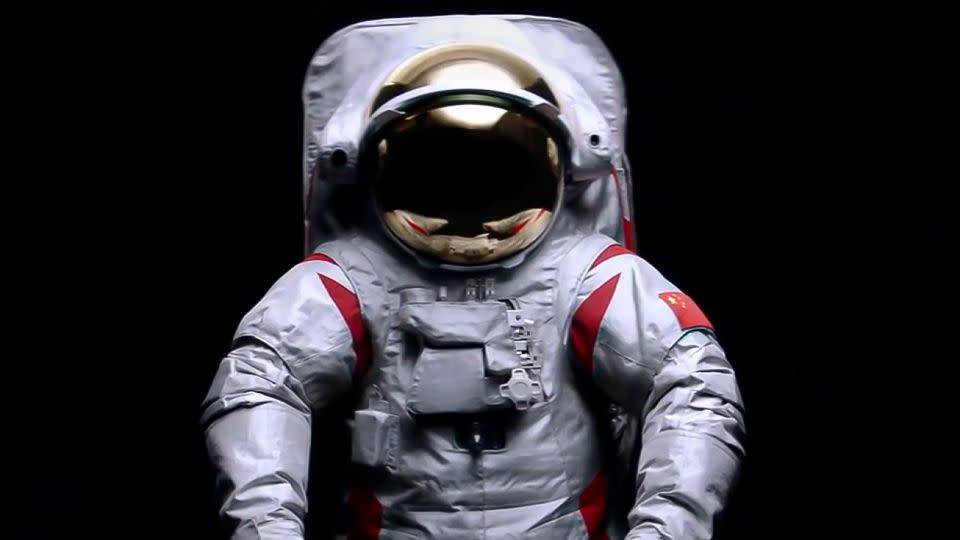China has taken a step forward in its ambitious plan to land astronauts on the moon by 2030 – unveiling the specially designed spacesuit its crew will don for what’s expected to be a landmark mission in the country’s space program.
The new red-and-white suit – revealed by the China Manned Space Agency (CMSA) over the weekend – is made to withstand the moon’s extreme temperatures, as well as radiation and dust, while allowing astronauts physical flexibility to perform tasks on the lunar surface, according to state media.
The moon-landing suit is equipped with a built-in long and short-range camera, an operations console, and a glare-proof helmet visor, according to a video shared by state broadcaster CCTV, which featured well-known Chinese astronauts Zhai Zhigang and Wang Yaping demonstrating how astronauts wearing the suit can bend and climb a ladder.
The new technology has caught international attention.
SpaceX CEO Elon Musk shared a post on the platform X featuring the CCTV video and his own caption.
“Meanwhile, back in America, the [Federal Aviation Administration (FAA)] is smothering the national space program in kafkaesque paperwork!” he wrote, in an apparent reference to the perceived speed with which China has bolstered its space program relative to the US.
CNN has reached out to FAA for comment.
SpaceX’s fortunes – and Musk’s personal wealth – have been boosted in recent years by huge government contracts as NASA has sought to tap into the private sector on space exploration and logistics.

Space leader
China’s reveal of the moon-landing spacesuit comes as the country has mounted a significant effort to establish itself a major player in space – a domain that nations, including the United States, are increasingly looking to not only for scientific benefit, but also with an eye to resources and national security.
The China National Space Administration has in recent years carried out a series of increasingly complex robotic lunar missions, including the first-ever return of lunar samples from the far side of the moon earlier this year. It has been angling to become the second country to land astronauts on the moon, saying its first crewed mission will take place “by 2030.”
The US, which has not sent astronauts to the moon since 1972, is also planning to send a crew this decade, though it has delayed its initial timeline for its Artemis III mission. That mission will not take off until at least September 2026, NASA said earlier this year. The agency revealed a protoype of its Artemis III spacesuit prototype, the AxEMU, in 2023.
China’s new spacesuit was hailed across state media as a major step forward in the country’s crewed mission timeline, with experts noting the need for specifically formulated suit for lunar conditions versus those used in spacewalks by astronauts at China’s Tiangong orbital space station.
Thanks to its thin exosphere, the moon is an unforgiving place, exposed to both the sun’s rays and the cold of space. Temperatures near the Moon’s equator, for example, can spike to 250°F (121°C) in the day and then plunge at night to -208°F (-133°C), according to NASA.
“Unlike low-Earth orbit missions, astronauts will be in a harsh natural lunar environment during lunar extravehicular activities. Complex environmental factors such as high vacuum and low gravity, lunar dust and lunar soil, complex lunar surface terrain, high and low temperatures, and strong radiation will have a significant impact on work and protection,” Wu Zhiqiang, deputy chief designer of astronaut systems at the China Astronaut Research and Training Center, told state broadcaster CCTV.
Others also hailed the aesthetics of the suit, with state media describing the red stripes on its upper limbs are inspired by ribbons from the “flying apsaras,” or deities that appear in ancient art in western China’s Dunhuang city, while those on its lower limbs resembling “rocket launch flames.”
Another designer, Wang Chunhui, told state media the suit’s proportions would make the astronauts “look more spirited and majestic” and “make us Chinese look strong and beautiful when we step on the moon.”
Earlier this year, Chinese officials released the name of the spacecraft for the crewed lunar mission – with the spaceship dubbed Mengzhou, or Dream Vessel, the lander, Lanyue, or Embracing the Moon.
The mission is designed as part of a broader set of lunar ambitions, which include China’s plans to establish an international lunar research station at the moon’s south pole by 2040.
For more CNN news and newsletters create an account at CNN.com
Source Agencies


